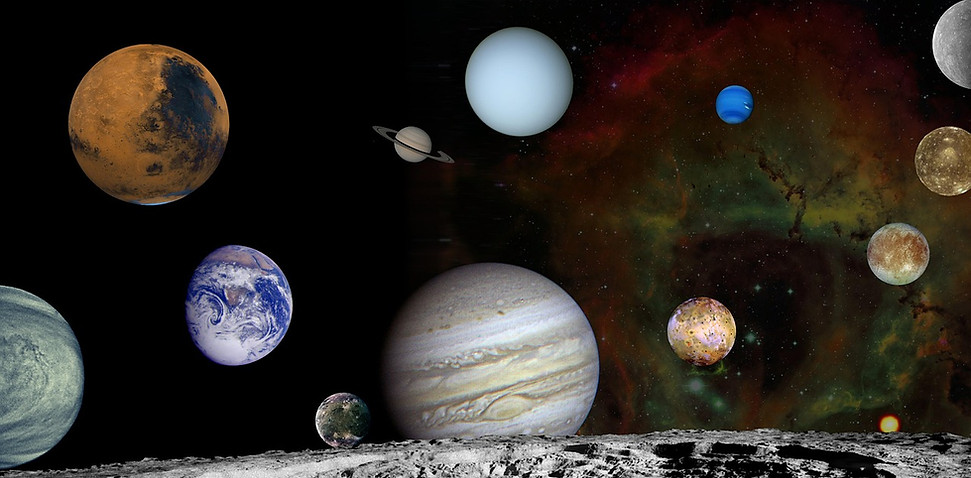
The Planets - Our Neighbors in the Solar System

This lesson contains affiliate links to products I have used and personally recommend. At no cost to you, I make a commission for purchases made through the links or advertisements. These commissions help to pay for the costs of the site and enable it to remain free for anyone who wants to use it.
Objectives:
-
The students will learn about the planets of the Solar System.
-
The students will be able to name the planets of the Solar System.
Questions that encompasses the objective:
-
Have you ever looked up at the sky at night? What did you see?
-
Have you ever looked up at the sky during the day? What did you see?
-
What was missing from the day sky that was there at night?
Prepare the Learner: Activating Prior Knowledge.
How will students prior knowledge be activated?
Warm up by asking students:
-
What do you know about planets?
-
What do you know about the Solar System?
Common Core State Standards:
-
CCSS.ELA-LITERACY.SL.2.1
-
CCSS.ELA-LITERACY.SL.2.1 B
-
CCSS.ELA-LITERACY.SL.2.4
-
CCSS.ELA-LITERACY.W.2.2
-
CCSS.ELA-LITERACY.W.3.2
-
CCSS.ELA-LITERACY.W.3.2 B
-
CCSS.ELA-LITERACY.SL.3.1
-
CCSS.ELA-LITERACY.SL.3.4
Materials and Free Resources to Download for this Lesson:
-
-
Page 23: Planets of the Solar System
-
Page 24: Dwarf Planets of the Solar System
-
Pages 25-33: Individual pages on each planet
-
Pages 34: Rotation vs. Revolution
-
-
“Guess the Planet” activity
**When the unit is over, download the final assessment for all of the lessons on space for free.
Input:
What is the most important content in this lesson?
To reach this lesson’s objective, students need to understand:
-
The names and characteristics of the nine planets of the Solar System.
**Pluto, although a dwarf planet is included in the list.**
-
What a satellite is and which planets have satellites.
-
The difference between rotation and revolution.
-
How long it takes Earth to spin on its axis.
-
How long it takes Earth to orbit around the sun.
How will the learning of this content be facilitated?
-
For the first few minutes, the students will fill out the “What I Know About the Planets” worksheet.
-
The teacher will begin the class by showing either of two videos “The Solar System Song” (Source: https://www.youtube.com/watch?v=SMPmd2lTlvQ) or “The Planet Song” (Source: https://www.youtube.com/watch?v=IC3fRNFIgkQ). Both videos are about two minutes long and review the names and order of the planets in a kid-friendly way.
-
After the video has been shown, the teacher should review the content. It is important to explain that the Solar System is made up of more than just the Sun, Moon, and stars.
-
After the video is shown, the teacher will begin presenting the information on the Solar System. If it is possible, project each page of the teacher’s copy of the “All About the Solar System” Science Journal worksheet onto the board using a projector or put into a PowerPoint document and project. The teacher’s copy of the journal has certain words/phrases that are bolded red and highlighted. It is important the teacher explain to the students those words/phrases are to be highlighted in their (students) journal. For this lesson, the teacher should review these pages:
-
Page 23: Planets of the Solar System
** This page reviews the planets in the correct order. Refer back to the mnemonic if needed**
-
Page 24: Dwarf Planets of the Solar System
**This page discusses the 5 dwarf planets and why they are called “dwarf planets”**
-
Pages 25-33: Individual Pages on Planets
**Each page reviews a planet—name, order from the Sun, color, number of moons, and one important fact **
-
Page 34: Rotation vs. Revolution
**This page explains the difference between rotation and revolution**
-
After the information has been presented, the students will participate in the game, “Order the Planets.” Choose one student to be the Sun; one student to be the Moon; nine students to be each of the planets; the rest of the students can be stars, asteroids, comets, etc. The “planet students” will line up in the correct order. The “sun student” will be in the center. Then, show the orbit of Earth around the Sun. Have the “Moon student” walk around the “Earth student: to show how the Moon orbits the Earth. Have the “planet Earth student” walk around the “Sun student”. The other “planet students” can also walk around in a circle to show the orbit of their own planet.
-
After the game, the students will participate in the activity “Guess the Planet” word scramble. The students can work individually or in pairs.. The teacher should give each student a “Guess the Planet” word scramble worksheet. The students will read through each clue and unscramble the words to determine which planet is the answer. Allow the students about 15 minutes to complete the activity.
Closure
-
The students will then fill out the “What I Learned About Astronomers” worksheet.
-
They will then share with the class, or with a partner, some things they wrote down in their “What I Learned About Astronomers” page.
-
**The students should keep both of the "What I Know" and "What I Learned" sheets in a folder to put them all together into a book when the unit is finished.**
Time/Application
3-5 minutes
Guided Introduction
Review the class/ agenda with the students:
-
Discussion: Science Journal (Pages 23-33)
-
“Order the Planets” Game
-
Activity: “My Planet ”
-
Discussion of Activity
10 minutes
Video: “The Solar System Song” or “The Planet Song”
-
Show the students either video: “Solar System Song” by Hazel Browne
-
After the video is over, begin a discussion about the content.
20 Minutes
Planets of the Solar System | Rotation vs. Revolution | “Order the Planets” Game
-
Instruct the students to open to page 23 in their science journals.
-
Project each page of the science journal onto the board either through a projector or PowerPoint presentation.
-
The teacher copy has bolded red and highlighted words. The students will highlight those words in their science journal.
-
Begin presenting the information. The pages that will be presented include: pages 23-34.
-
After the information has been presented, play the game “Order the Planets.”
20 Minutes
Activity: “Guess the Planet” Word Scramble
-
The students can either work individually or in pairs.
-
Give each student a “Guess the Planet” Word Scramble
-
Instruct the students to read through each clue and unscramble the words to determine which planet is the answer.
-
Allow the students to work for about 15 minutes.
-
Reconvene and review when the students are finished.
Closure/Assessment
10 minutes
-
The students will fill out the “What I Learned About the Planets” worksheet.
-
They will then share with the class, or with a partner, some things they wrote down in their “What I Learned About the Planets” page.
**The students should keep both of the "What I Know" and "What I Learned" sheets in a folder to put them all together into a book when the unit is finished.**
Individualized Instruction/Scaffolding
English Language Learners will be supported in this lesson through data-based heterogeneous grouping, verbal and written repetition of new vocabulary words, and multiple representation of vocabulary words through printed images and video.

















